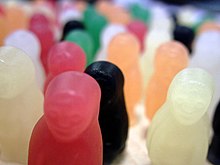Jelly Babies: Difference between revisions
Nedrutland (talk | contribs) Undid revision 424120141 by 108.7.196.192 (talk) |
changed "The introduction of different shapes and names was a new innovation" to "The introduction of different shapes and names was an innovation". "New innovation" is a tautology (at least in my estimation). |
||
| Line 14: | Line 14: | ||
[[Image:Jelly babies.jpg|thumb|Jelly babies|left]] |
[[Image:Jelly babies.jpg|thumb|Jelly babies|left]] |
||
Each Bassett's jelly baby now has an individual name and shape, colour and flavour: Brilliant (red - strawberry), Bubbles (yellow - lemon), Baby Bonny (pink - raspberry), Boofuls (green - lime), Bigheart (purple - blackcurrant) and Bumper (orange). The introduction of different shapes and names was |
Each Bassett's jelly baby now has an individual name and shape, colour and flavour: Brilliant (red - strawberry), Bubbles (yellow - lemon), Baby Bonny (pink - raspberry), Boofuls (green - lime), Bigheart (purple - blackcurrant) and Bumper (orange). The introduction of different shapes and names was an innovation, circa 1989, prior to which all colours of jelly baby were a uniform shape. |
||
Jelly babies are similar in appearance to [[gummi bear]]s, which are better known outside of the United Kingdom, though the texture is different, Jelly Babies having a harder outer layer and a softer, less rubbery, centre. |
Jelly babies are similar in appearance to [[gummi bear]]s, which are better known outside of the United Kingdom, though the texture is different, Jelly Babies having a harder outer layer and a softer, less rubbery, centre. |
||
Revision as of 14:04, 16 April 2011
Jelly babies are a type of soft confectionery that look like little babies in a variety of colours. There are currently several brands of jelly babies, most predominantly Trebor Bassett (part of the Cadbury group of companies and also famous for their liquorice allsorts), Rowntree (a Nestlé brand), and Norfolk Manor.
Jelly babies were launched by Bassett's in 1918 in Sheffield as "Peace Babies" to mark the end of World War I. Production was suspended during World War II due to wartime shortages. In 1953 the product was relaunched as "Jelly Babies". In March 1989 Bassett's were taken over by Cadbury—Schweppes, who had earlier acquired the Trebor brand.
A line of sweets called Jellyatrics were launched by Barnack Confectionery Ltd to commemorate the Jelly Baby's 80th birthday.[1]
Jelly babies manufactured in the United Kingdom tend to be dusted in starch which is left over from the manufacturing process where it is used to aid release from the mould. Jelly babies of Australian manufacture generally lack this coating.
Like most other gummi sweets, they contain gelatin.
A popular science class experiment is to put them in a strong oxidising agent and see the resulting spectacular reaction. The experiment is commonly referred to as "screaming jelly babies".

Each Bassett's jelly baby now has an individual name and shape, colour and flavour: Brilliant (red - strawberry), Bubbles (yellow - lemon), Baby Bonny (pink - raspberry), Boofuls (green - lime), Bigheart (purple - blackcurrant) and Bumper (orange). The introduction of different shapes and names was an innovation, circa 1989, prior to which all colours of jelly baby were a uniform shape.
Jelly babies are similar in appearance to gummi bears, which are better known outside of the United Kingdom, though the texture is different, Jelly Babies having a harder outer layer and a softer, less rubbery, centre.
In 2007, Bassett's jelly babies changed to include only natural colours and ingredients.[2]
In 2009, a poll of 4,000 British adults voted jelly babies their 6th favourite sweet.[3]
In popular culture
In the early 1960s, after Beatles guitarist George Harrison revealed in an interview that he liked jelly babies, audiences showered him and the rest of the band with the sweets at live concerts and fans sent boxes of them as gifts.[citation needed] Unfortunately, American fans could not obtain this soft British confection, replacing them with harder jelly beans instead. To the group's discomfort, they were frequently pelted with jelly beans during concerts while in the U.S.[citation needed]
Jelly babies have been a perennial feature in the television series Doctor Who. The Second Doctor was the first to have them in his pockets, and in the 1996 Doctor Who film, the Seventh Doctor is seen eating them and the Eighth Doctor later offers some to a police officer; but they are most associated with the Fourth Doctor. He had them throughout his lengthy time on the show, and indeed they became one of several defining characteristics of this incarnation of the character. One of this Doctor's most recognised catchphrases is "Would you like a jelly baby?" In the 2007 Tenth Doctor episode "The Sound of Drums", The Master is also seen eating them.
References
- ^ [1]
- ^ "Confectionery giants cut use of artificial additives".
- ^ Alex Renton (10 September 2009). "Humbugs, mints, gums and our Top 20 sweets". The Times. Retrieved 25 January 2011.
